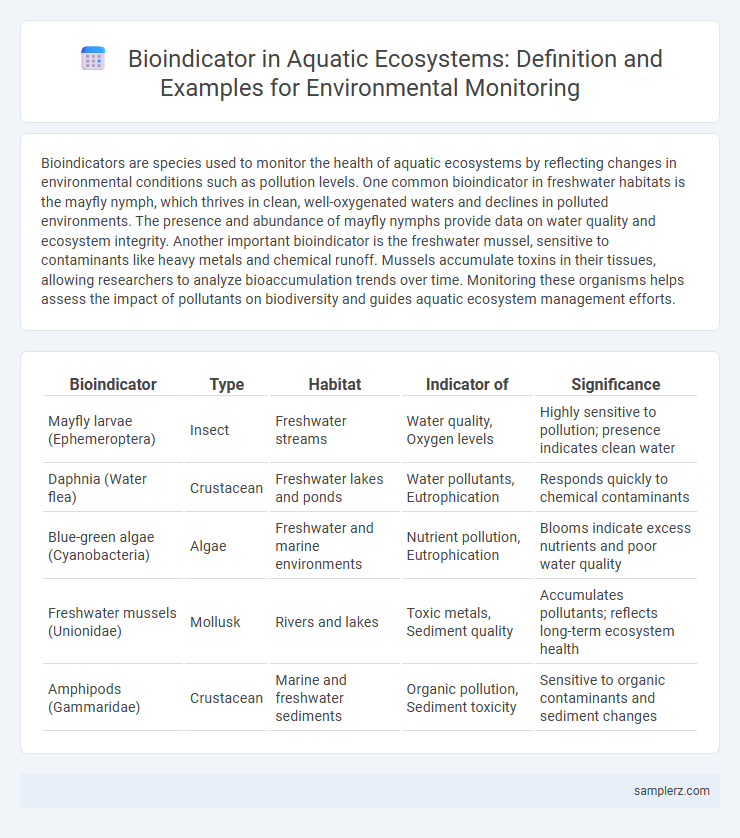Bioindicators are species used to monitor the health of aquatic ecosystems by reflecting changes in environmental conditions such as pollution levels. One common bioindicator in freshwater habitats is the mayfly nymph, which thrives in clean, well-oxygenated waters and declines in polluted environments. The presence and abundance of mayfly nymphs provide data on water quality and ecosystem integrity. Another important bioindicator is the freshwater mussel, sensitive to contaminants like heavy metals and chemical runoff. Mussels accumulate toxins in their tissues, allowing researchers to analyze bioaccumulation trends over time. Monitoring these organisms helps assess the impact of pollutants on biodiversity and guides aquatic ecosystem management efforts.
Table of Comparison
| Bioindicator | Type | Habitat | Indicator of | Significance |
|---|---|---|---|---|
| Mayfly larvae (Ephemeroptera) | Insect | Freshwater streams | Water quality, Oxygen levels | Highly sensitive to pollution; presence indicates clean water |
| Daphnia (Water flea) | Crustacean | Freshwater lakes and ponds | Water pollutants, Eutrophication | Responds quickly to chemical contaminants |
| Blue-green algae (Cyanobacteria) | Algae | Freshwater and marine environments | Nutrient pollution, Eutrophication | Blooms indicate excess nutrients and poor water quality |
| Freshwater mussels (Unionidae) | Mollusk | Rivers and lakes | Toxic metals, Sediment quality | Accumulates pollutants; reflects long-term ecosystem health |
| Amphipods (Gammaridae) | Crustacean | Marine and freshwater sediments | Organic pollution, Sediment toxicity | Sensitive to organic contaminants and sediment changes |
Introduction to Bioindicators in Aquatic Ecosystems
Bioindicators such as benthic macroinvertebrates play a crucial role in assessing water quality in aquatic ecosystems by reflecting the cumulative impact of environmental changes. Species like mayflies, caddisflies, and stoneflies are sensitive to pollution levels, making their presence or absence a reliable indicator of ecosystem health. Monitoring these organisms provides essential data for detecting contamination and guiding conservation efforts in freshwater habitats.
Importance of Bioindicators for Water Quality Assessment
Daphnia species serve as critical bioindicators in aquatic ecosystems, providing valuable insights into water quality through their sensitivity to pollutants such as heavy metals and pesticides. Monitoring Daphnia populations enables early detection of toxic substances, facilitating timely interventions to protect aquatic life and human health. Their presence and behavior reflect ecological changes, making them essential for effective water quality assessment and management.
Role of Macroinvertebrates as Aquatic Bioindicators
Macroinvertebrates such as mayflies, caddisflies, and stoneflies serve as critical bioindicators in aquatic ecosystems due to their sensitivity to pollution and habitat changes. Their presence, diversity, and population dynamics provide valuable information on water quality and ecological health, reflecting long-term environmental conditions. Monitoring macroinvertebrate communities helps detect pollution sources, assess the impact of restoration efforts, and guide sustainable water management practices.
Algae Community as Biological Indicators of Pollution
Algae communities serve as critical bioindicators in aquatic ecosystems due to their sensitivity to changes in water quality and pollutant levels. Variations in species composition, abundance, and chlorophyll concentration within algae populations directly reflect nutrient loading, chemical contaminants, and oxygen depletion caused by pollution. Monitoring shifts in algae diversity, such as the proliferation of blue-green algae (cyanobacteria) in eutrophic waters, provides valuable data for assessing the ecological health and pollution status of freshwater habitats.
Fish Species and Their Indicator Value in Water Bodies
Fish species such as the trout (Salmo trutta) serve as vital bioindicators in aquatic ecosystems due to their sensitivity to changes in water quality, including oxygen levels, pH, and pollutant concentrations. Presence or absence of trout populations can reveal the health of freshwater bodies, indicating levels of heavy metals, nitrates, and organic pollutants. Monitoring shifts in fish community composition helps detect early signs of ecological imbalance and water contamination.
Amphibians as Sensitive Bioindicators in Aquatic Habitats
Amphibians such as frogs and salamanders serve as sensitive bioindicators in aquatic ecosystems due to their permeable skin and complex life cycles, which make them highly susceptible to pollutants, habitat degradation, and changes in water quality. Their presence, abundance, and health directly reflect the ecological conditions of freshwater habitats, providing early warning signals of environmental stress or contamination. Monitoring amphibian populations helps assess ecosystem integrity, detect emerging threats from chemical pollutants, and guide conservation efforts in aquatic environments.
Phytoplankton Diversity as Water Quality Indicators
Phytoplankton diversity serves as a key bioindicator in aquatic ecosystems, reflecting variations in water quality through shifts in species composition and abundance. High diversity typically indicates balanced nutrient levels and minimal pollution, while dominance by specific tolerant species signals eutrophication or contamination. Monitoring phytoplankton communities provides critical data for assessing ecological health and guiding water management strategies.
Bivalves and Mollusks for Monitoring Aquatic Health
Bivalves and mollusks serve as effective bioindicators in aquatic ecosystems due to their sensitivity to changes in water quality and pollutant accumulation. Species such as freshwater mussels accumulate heavy metals, pesticides, and other contaminants, providing valuable data on the presence and concentration of environmental toxins. Monitoring these organisms helps assess ecosystem health, detect pollution sources, and guide conservation efforts aimed at preserving aquatic biodiversity.
Use of Aquatic Plants as Bioindicators of Ecosystem Changes
Aquatic plants such as submerged macrophytes serve as effective bioindicators for monitoring ecosystem changes in freshwater environments by reflecting water quality and nutrient status. Species like Potamogeton and Elodea respond sensitively to variations in pollution levels, highlighting the presence of contaminants such as heavy metals or excess nitrogen and phosphorus. Their health and distribution patterns provide critical data for assessing the ecological impact of anthropogenic activities in aquatic ecosystems.
Comparative Case Studies of Bioindicators in Aquatic Systems
Mayfly nymphs (Ephemeroptera) serve as effective bioindicators in freshwater streams, indicating high oxygen levels and low pollution. In contrast, tubifex worms thrive in organically polluted waters, reflecting poor water quality and hypoxic conditions. Comparative studies show that shifts in species composition, such as the decline of sensitive mayflies and the increase of tolerant tubifex worms, reveal the ecological health and pollution gradients in aquatic ecosystems.

example of bioindicator in aquatic ecosystem Infographic
 samplerz.com
samplerz.com